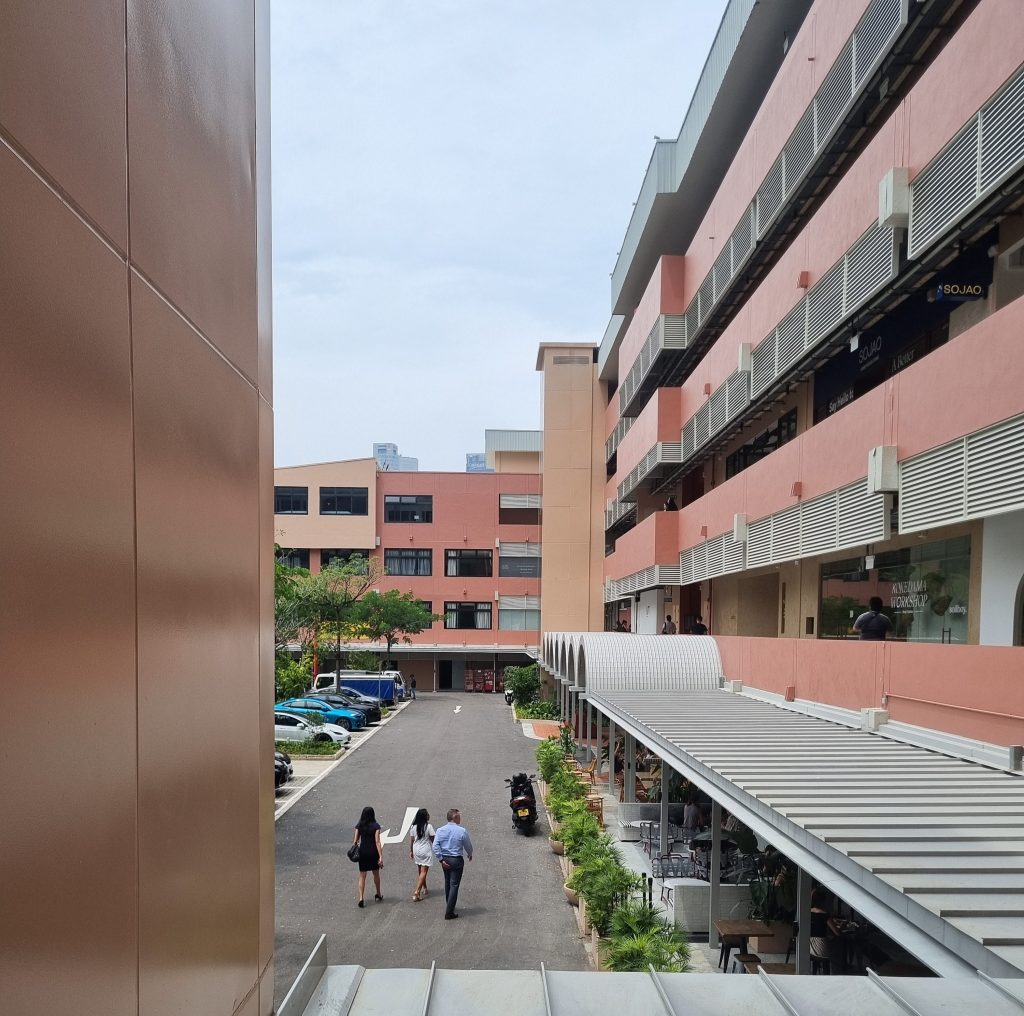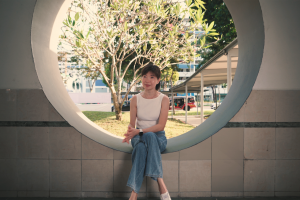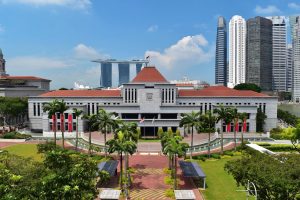All images by Elliot Lee.
On a sweltering Wednesday afternoon, I show up to New Bahru in a T-shirt and shorts. I’m woefully out of place here, among the bougie cafés and restaurants, the luxury homeware brands, and the fancy clientele.
New Bahru markets itself as a “creative lifestyle destination” housing over 40 homegrown creative businesses. It’s housed on the grounds of the former Nan Chiau High School, with the aim of preserving this heritage building—which served as headquarters for volunteer soldiers during the Japanese Occupation before being turned into a school in the 1960s.
ADVERTISEMENT
Wee Teng Wen, the landlord and main man behind New Bahru, seems to have good intentions. Before #supportlocal was a thing, in 2005, he started the rooftop bar Loof, which embraces Singaporeanness in its name and its cocktails. He’s also the managing partner of Lo & Behold, the F&B and hospitality group that’s been quietly shaping Singapore’s lifestyle scene for years.
Wee says he sees “a need to boost the image of Singapore brands among Singaporeans who place more value on shiny foreign imports”, and New Bahru is his answer to that problem. He’s also drawn to heritage buildings, which is why New Bahru preserves much of the original architecture of the old school.
In a country that is constantly accused of lacking culture, I admire the attempt to raise the prominence of homegrown brands and local heritage. I’m just not sure if New Bahru furthers that goal—or if it only does so for a certain crowd.
Parking Privileges
When I arrive, the entire setup of the mall signals to me that it’s targeted at a certain socioeconomic class. First off, it’s located in the River Valley area, which is in District 9—it goes without saying that it’s pretty atas.
ADVERTISEMENT
New Bahru is also a 10- to 15-minute walk from the nearest MRT (Fort Canning). The mall is clearly designed around cars: I’m greeted by a LED sign showing the number of lots, and a large portion of the space is taken up by a parking lot. All this despite New Bahru encouraging sustainability and “car-lite means of commute”.
The parking lot is pretty full, too. I’m surprised that there are so many people in the mall on a Wednesday afternoon. Clearly, those who patronise this space don’t work a 9-to-6 like the rest of us.
The selection of brands reflects that as well. It’s great that New Bahru gathers a whole bunch of Singaporean brands—like Sea Apple, OM, Soilboy, PPP Coffee, and The Coconut Club—in one place. It’s probably the only mall in the country that does that. In other malls, independent local brands often have to compete with big chains and international brands for retail space.
These brands are chichi, artisanal, and all about sustainability. They’re also out of my budget.

Class Dismissed
It’s none of my business if people spend their money on fancy stuff, but it doesn’t stop me from being annoyed anyway. I think part of that indignation comes from New Bahru’s marketing.
The mall prides itself on being a “creative cluster for Singapore”.
I’ll give them props for the creativity. It looks distinctively different from your usual cookie-cutter mall, managing a tricky blend of pragmatism and the past. It maintains the facade and feeling of the old school, without that oppressive feeling you get from spending half your day at a rickety desk.
There’s no air-con in the open-air spaces, which pisses me off after 15 minutes of walking in the noonday sun. But I have to admit it gives New Bahru a certain vibe: it’s pretty airy (there are fans) and there are great views of the neighbourhood, something you wouldn’t get in a typical mall. It’s a beautiful space, for sure.
But it also feels very sterile. Every store looks the same—the glass-panelled walls and sans-serif fonts blend into one another after a while.
And I’m not entirely convinced it’s “for Singapore”.
The whole place seems very disconnected from the average Singaporean. Based on what I’m seeing, most of the people shopping in this mall are tourists, affluent expats, and well-heeled Singaporeans.
It’s a jarring juxtaposition—not between the old and the new-new, but between a school for the masses and a mall for the prosperous few.
It all feels very Crazy Rich Asians or David Yong-esque—a place that lays claim to Singaporeanness, but doesn’t feel relatable to most Singaporeans. It’s an expensive, polished retail playground for the rich built on the bones of history.

History and Hype
And as much as New Bahru tries to pay tribute to its history, that doesn’t seem to be what people are visiting for.
I mean, it’s really nice that they’re preserving this campus rather than demolishing it. And it was genuinely fascinating to check out the old school hall (before it gets turned into a “cultural gallery”, anyway).
But in the hour that I spent there, I didn’t see anyone entering the school hall—clearly people aren’t here for the heritage. Maybe it’s not Instagrammable enough.
To be fair, no one (besides alumni) really cared about this place until New Bahru set up shop. I mean, the only reason I’m here is because it’s a brand-new shopping mall.
I just wonder if there isn’t another way to preserve the architecture and history of the school, besides turning it into another shopping mall—a high-end one, at that.
For example, the Singapore Art Museum is built on the grounds of two old schools, but it managed to preserve their architecture while being a culturally enriching space.
And the Peace Centre during PlayPan’s tenancy spotlighted local enterprises too. There were some shops that sold expensive things like original art pieces, but the place didn’t feel inaccessible in the way that a lot of New Bahru’s shops do. With things like thrift shops, community spaces, and free exhibitions peppered throughout, there was a sense it was truly a space for all.
In an ideal world, all heritage buildings would be conserved simply by virtue of their historical value. But we live in a capitalist society, and New Bahru is a money-making enterprise after all. Museums don’t exactly rake in the moolah, and Peace Centre (before PlayPan) was sold off to developers when people simply stopped visiting the mall. And if New Bahru has to get its money from somewhere, better it be from the well-to-do.

It’s a complicated line to tread between conservation and gentrification. And honestly, if I were Wee Teng Wen, I’d probably do the same thing. When you’re spending $25 million to redevelop a mall in one of the most affluent neighbourhoods in the country, better to market to your target audience, right?
But that marketing has made me, and many other Singaporeans, I’m sure, feel alienated.
That’s not a knock on any of the brands there, many of which represent Singaporeans’ attempts to be entrepreneurial and have global relevance.
Gentrification, the process of turning an area or neighbourhood atas, gets a bad rep. But in the case of New Bahru, it feels like there are no bad guys here. As we inevitably have to repurpose spaces that have fallen into disuse, this feels like a step in the right direction.
Consider the alternatives: Razing the school to the ground to build a new mall (you lose the architecture) or populating New Bahru with more affordable shops (who’s going to keep the lights on?).
Of course, it doesn’t feel good at all to step into a space littered with artefacts of a different socioeconomic class: fancy cars, $7 coffees, and hundred-dollar potted plants.
After spending a while there, it’s clear that it’s an atas place for an atas crowd. If you’re on my end of the income spectrum, this place is not for us. And that’s okay.





